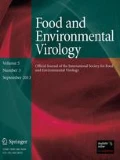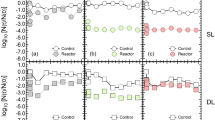Abstract
Adsorption to aquifer media is an important process in the removal of viruses from groundwater. Even though hydrophobic interactions have been shown to contribute to adsorption, little is known about the hydrophobicity of viruses found in groundwater. In this study, the hydrophobicity of rotavirus, MS2 bacteriophage and DNA-labelled silica nanoparticles (SiNPs) coated with glycoprotein, protein A and alpha-1-microglobulin/bikunin precursor (AMBP) was investigated. The hydrophobicity was experimentally determined by using a modified microbial adhesion to hydrocarbons (MATH) assay. The results were compared with the theoretical hydrophobicity of the viral capsid proteins and the proteins used to coat the nanoparticles, and with the results of adsorption tests with unmodified and organosilane-coated (hydrophobic) silica sand. While most theoretical protein hydrophobicity values were similar, the results of the MATH assay suggested fundamental differences in the hydrophobicity of the viruses and the SiNPs. MS2 was found to be highly hydrophobic as based on the MATH hydrophobicity and a significantly enhanced adsorption to hydrophobic sand, whereas rotavirus was relatively hydrophilic. The MATH assay revealed that protein-coating of SiNP introduced some degree of hydrophobicity to hydrophilic SiNPs, enabling them to more closely mimic viral hydrophobicity. Our study also demonstrated that the protein-coated SiNPs better mimicked rotavirus adsorption to sand media (coated or not coated with hydrophobic organic matter) than the MS2. This further supports previous findings that these surface-modified SiNPs are useful surrogates in mimicking rotavirus retention and transport in porous media.



Similar content being viewed by others
References
Adams, M. H. (1959). Enumeration of Bacteriophage Particles. In M. H. Adams (Ed.), Bacteriophages (pp. 27–32). New York: Interscience publisher.
Agarwal, A., Sankaran, S., Vajpayee, M., Sreenivas, V., Seth, P., & Dandekar, S. (2007). Correlation of immune activation with HIV-1 RNA levels assayed by real-time RT-PCR in HIV-1 subtype C infected patients in Northern India. Journal of Clinical Virology, 40(4), 301–306.
Aronino, R., Dlugy, C., Arkhangelsky, E., Shandalov, S., Oron, G., Brenner, A., et al. (2009). Removal of viruses from surface water and secondary effluents by sand filtration. Water Research, 43(1), 87–96.
Attinti, R., Wei, J., Kniel, K., Thomas Sims, J., & Jin, Y. (2010). Virus’ (MS2, PdblX174, and Aichi) attachment on sand measured by atomic force microscopy and their transport through sand columns. Environmental Science and Technology, 44(7), 2426–2432.
Bales, R. C., Hinkle, S. R., Kroeger, T. W., Stocking, K., & Gerba, C. P. (1991). Bacteriophage adsorption during transport through porous media: Chemical perturbations and reversibility. Environmental Science and Technology, 25(12), 2088–2095.
Bales, R. C., Li, S., Maguire, K. M., Yahya, M. T., & Gerba, C. P. (1993). MS-2 and poliovirus transport in porous media: Hydrophobic effects and chemical perturbations. Water Resources Research, 29(4), 957–963.
Bales, R. C., Li, S., Yeh, T. C. J., Lenczewski, M. E., & Gerba, C. P. (1997). Bacteriophage and microsphere transport in saturated porous media: Forced-gradient experiment at Borden, Ontario. Water Resources Research, 33(4), 639–648.
Cao, H., Tsai, F. T. C., & Rusch, K. A. (2010). Salinity and soluble organic matter on virus sorption in sand and soil columns. Ground Water, 48(1), 42–52.
Chrysikopoulos, C. V., & Aravantinou, A. F. (2012). Virus inactivation in the presence of quartz sand under static and dynamic batch conditions at different temperatures. Journal of Hazardous Materials, 233–234, 148–157.
Chu, Y., Jin, Y., & Yates, M. V. (2000). Virus transport through saturated sand columns as affected by different buffer solutions. Journal of Environmental Quality, 29(4), 1103–1110.
Clark, K. J., Sarr, A. B., Grant, P. G., Phillips, T. D., & Woode, G. N. (1998). In vitro studies on the use of clay, clay minerals and charcoal to adsorb bovine rotavirus and bovine coronavirus. Veterinary Microbiology, 63(2–4), 137–146.
Davis, J. A., Farrah, S. R., & Wilkie, A. C. (2006). Adsorption of viruses to soil: Impact of anaerobic treatment. Water Science and Technology, 54, 161–167.
Dizer, H., Nasser, A., & Lopez, J. M. (1984). Penetration of different human pathogenic viruses into sand columns percolated with distilled water, groundwater, or wastewater. Applied and Environment Microbiology, 47(2), 409–415.
Doyle, R. J., & Rosenberg, M. (1990). Microbial cell surface hydrophobicity: history, measurement, and significance. In R. J. Doyle & M. Rosenberg (Eds.), Microbial cell surface hydrophobicity (pp. 1–38). Washington, D.C.: American Society of Microbiology.
Dreier, J., Störmer, M., & Kleesiek, K. (2005). Use of bacteriophage MS2 as an internal control in viral reverse transcription-PCR assays. Journal of Clinical Microbiology, 43(9), 4551–4557.
Espinosa, A. C., Mazari-Hiriart, M., Espinosa, R., Maruri-Avidal, L., Méndez, E., & Arias, C. F. (2008). Infectivity and genome persistence of rotavirus and astrovirus in groundwater and surface water. Water Research, 42(10–11), 2618–2628.
Farkas, K., Pang, L., Lin, S., Williamson, W., Easingwood, R., Fredericks, R., et al. (2013). A gel filtration-based method for the purification of infectious rotavirus particles for environmental research applications. Food and Environmental Virology, 5(4), 231–235.
Gerba, C. P. (1984). Applied and theoretical aspects of virus adsorption to surfaces. Advances in Applied Microbiology, 30, 133–168.
Goyal, S. M., & Gerba, C. P. (1979). Comparative adsorption of human enteroviruses, simian rotavirus, and selected bacteriophages to soils. Applied and Environment Microbiology, 38(2), 241–247.
Gutierrez, L., Li, X., Wang, J., Nangmenyi, G., Economy, J., Kuhlenschmidt, T. B., et al. (2009). Adsorption of rotavirus and bacteriophage MS2 using glass fiber coated with hematite nanoparticles. Water Research, 43(20), 5198–5208.
Gutierrez, L., Mylon, S. E., Nash, B., & Nguyen, T. H. (2010). Deposition and aggregation kinetics of rotavirus in divalent cation solutions. Environmental Science and Technology, 44(12), 4552–4557.
Han, J., Jin, Y., & Willson, C. S. (2006). Virus retention and transport in chemically heterogeneous porous media under saturated and unsaturated flow conditions. Environmental Science and Technology, 40(5), 1547–1555.
Herbold-Paschke, K., Straub, U., Hahn, T., Teutsch, G., & Botzenhart, K. (1991). Behaviour of pathogenic bacteria, phages and viruses in groundwater during transport and adsorption. Water Science and Technology, 24(2), 301–304.
Jin, Y., Chu, Y., & Li, Y. (2000). Virus removal and transport in saturated and unsaturated sand columns. Journal of Contaminant Hydrology, 43(2), 111–128.
John, D. E., & Rose, J. B. (2005). Review of factors affecting microbial survival in groundwater. Environmental Science and Technology, 39(19), 7345–7356.
LaBelle, R. L., & Gerba, C. P. (1979). Influence of pH, salinity, and organic matter on the adsorption of enteric viruses to estuarine sediment. Applied and Environment Microbiology, 38(1), 93–101.
Larson, A. M., Hsu, B. B., Rautaray, D., Haldar, J., Chen, J., & Klibanov, A. M. (2011). Hydrophobic polycationic coatings disinfect poliovirus and rotavirus solutions. Biotechnology and Bioengineering, 108(3), 720–723.
Mellou, K., Katsioulis, A., Potamiti-Komi, M., Pournaras, S., Kyritsi, M., Katsiaflaka, A., et al. (2014). A large waterborne gastroenteritis outbreak in central Greece, March 2012: Challenges for the investigation and management. Epidemiology and Infection, 142(1), 40–50.
Meschke, J. S., & Sobsey, M. D. (1998). Comparative adsorption of Norwalk virus, poliovirus 1 and F + RNA coliphage MS2 to soils suspended in treated wastewater. Water Science and Technology, 38(12), 187–189.
Mondal, P. K., & Sleep, B. E. (2013). Virus and virus-sized microsphere transport in a dolomite rock fracture. Water Resources Research, 49(2), 808–824.
Olsthoorn, R., & Duin, J. (2011). Levivirus. In C. Tidona & G. Darai (Eds.), The Springer Index of Viruses (pp. 799–804). New York: Springer.
Pang, L., Farkas, K., Bennett, G., Varsani, A., Easingwood, R., Tilley, R., et al. (2014). Mimicking Retention and Transport of Rotavirus and Adenovirus in Sand Media Using DNA-labeled, Protein-coated Silica Nanoparticles. Water Research, 64, 167–179.
Pang, L., Nowostawska, U., Ryan, J. N., Williamson, W. M., Walshe, G., & Hunter, K. A. (2009). Modifying the surface charge of pathogen-sized microspheres for studying pathogen transport in groundwater. Journal of Environmental Quality, 38(6), 2210–2217.
Pham, M., Mintz, E. A., & Nguyen, T. H. (2009). Deposition kinetics of bacteriophage MS2 to natural organic matter: Role of divalent cations. Journal of Colloid and Interface Science, 338(1), 1–9.
Pinto, F., Maillard, J. Y., Denyer, S. P., & McGeechan, P. (2010). Polyhexamethylene biguanide exposure leads to viral aggregation. Journal of Applied Microbiology, 108(6), 1880–1888.
Räsänen, S., Lappalainen, S., Kaikkonen, S., Hämäläinen, M., Salminen, M., & Vesikari, T. (2010). Mixed viral infections causing acute gastroenteritis in children in a waterborne outbreak. Epidemiology and Infection, 138(9), 1227–1234.
Rosenberg, M. (2006). Microbial adhesion to hydrocarbons: Twenty-five years of doing MATH. FEMS Microbiology Letters, 262(2), 129–134.
Saini, G., Nasholm, N., Dolan, M. E., & Wood, B. D. (2011). Application of salting-out agent to enhance the hydrophobicity of weakly hydrophobic bacterial strains. Journal of Adhesion Science and Technology, 25(17), 2169–2182.
Schijven, J. F., & Hassanizadeh, S. M. (2000). Removal of viruses by soil passage: Overview of modeling, processes, and parameters. Critical Reviews in Environmental Science and Technology, 30(1), 49–127.
Sidhu, J. P. S., Toze, S., Hodgers, L., Shackelton, M., Barry, K., Page, D., et al. (2010). Pathogen inactivation during passage of stormwater through a constructed reedbed and aquifer transfer, storage and recovery. Water Science and Technology, 62(5), 1190–1197.
Syngouna, V. I., & Chrysikopoulos, C. V. (2010). Interaction between viruses and clays in static and dynamic batch systems. Environmental Science and Technology, 44(12), 4539–4544.
van Voorthuizen, E. M., Ashbolt, N. J., & Schäfer, A. I. (2001). Role of hydrophobic and electrostatic interactions for initial enteric virus retention by MF membranes. Journal of Membrane Science, 194(1), 69–79.
Varki, A., & Lowe, J. B. (2009). Biological Roles of Glycans. In A. Varki, R. D. Cummings, J. D. Esko, H. H. Freeze, P. Stanley, C. R. Bertozzi, et al. (Eds.), Essentials of Glycobiology (Vol. 2). Cold Spring Harbor, NY: Cold Spring Harbor Laboratory Press.
Wait, D. A., & Sobsey, M. D. (1983). Method for recovery of enteric viruses from estuarine sediments with chaotropic agents. Applied and Environment Microbiology, 46(2), 379–385.
Weaver, L., Sinton, L. W., Pang, L., Dann, R., & Close, M. (2013). Transport of microbial tracers in clean and organically contaminated silica sand in laboratory columns compared with their transport in the field. Science of the Total Environment, 443, 55–64.
Weisbrod, N., Meron, H., Walker, S., & Gitis, V. (2013). Virus transport in a discrete fracture. Water Research, 47(5), 1888–1898.
Wong, K., Voice, T. C., & Xagoraraki, I. (2013). Effect of organic carbon on sorption of human adenovirus to soil particles and laboratory containers. Water Research, 47(10), 3339–3346.
Yang, Z., Burlage, R. S., Sanford, W. E., & Moline, G. R. (1996). DNA-labeled silica microspheres for groundwater tracing and colloid transport studies. ACS Division of Environmental Chemistry, Preprints, 36(2), 156–158.
Zhang, H., Zhang, J., Zhao, B., & Zhang, C. (2010). Removal of bacteriophages MS2 and phiX174 from aqueous solutions using a red soil. Journal of Hazardous Materials, 180(1–3), 640–647.
Acknowledgments
This work was funded by the Royal Society of New Zealand (Marsden Grant ESR-1001). The authors thank the following people for their support and assistance: M. Male (University of Canterbury, New Zealand), W. Williamson, S. Lin, P. Scholes, B. Robson, E. McGill (Institute of Environmental Science & Research Ltd, New Zealand), P. Colvin (Polytechnic Institute of Technology, New Zealand) and G. Bennett (Bennett Scientific Services, New Zealand).
Author information
Authors and Affiliations
Corresponding author
Rights and permissions
About this article
Cite this article
Farkas, K., Varsani, A. & Pang, L. Adsorption of Rotavirus, MS2 Bacteriophage and Surface-Modified Silica Nanoparticles to Hydrophobic Matter. Food Environ Virol 7, 261–268 (2015). https://doi.org/10.1007/s12560-014-9171-3
Received:
Accepted:
Published:
Issue Date:
DOI: https://doi.org/10.1007/s12560-014-9171-3




